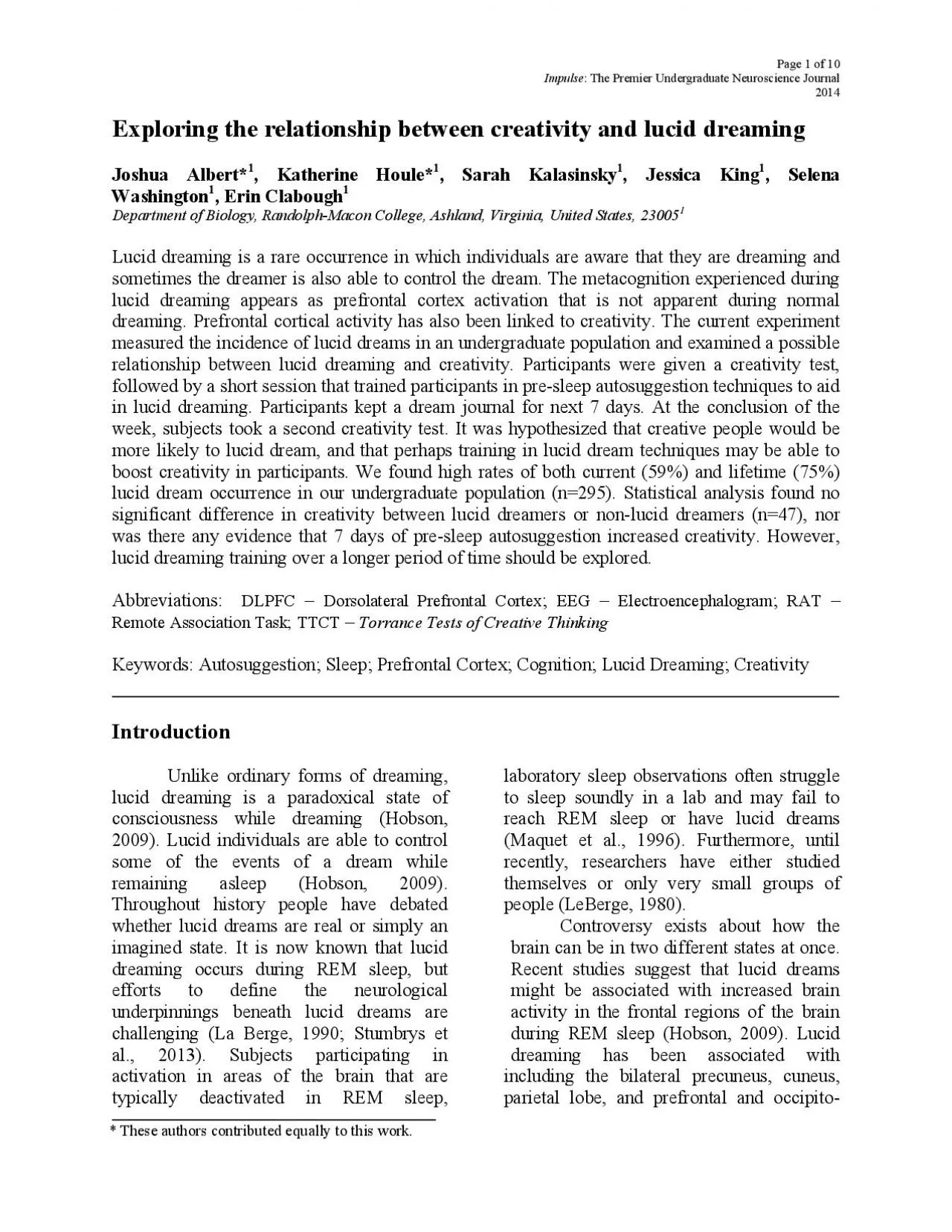

individuals are aware that they are dreaming and sometimes the dreamer is also able to control the dream The metacognition experienced during lucid dreaming appears as prefrontal cortex activation th ID: 951428
Download Pdf The PPT/PDF document "Jessica King1 Selena Washington" is the property of its rightful owner. Permission is granted to download and print the materials on this web site for personal, non-commercial use only, and to display it on your personal computer provided you do not modify the materials and that you retain all copyright notices contained in the materials. By downloading content from our website, you accept the terms of this agreement.
, Jessica King1, Selena Washington individuals are aware that they are dreaming and sometimes the dreamer is also able to control the dream. The metacognition experienced during lucid dreaming appears as prefrontal cortex activation that is not apparent during normal dreaming. Prefrontal cortical activity has also been linked to creativity. The current experiment measured the incidence of lucid dreams in an undergraduate population and examined a possible rel
ationship between lucid dreaming and creativity. Participants were given a creativity test, followed by a short session that trained participants in pre-sleep autosuggestion techniques to aid in lucid dreaming. Participants kept a dream journal for next 7 days. At the conclusion of the week, subjects took a second creativity test. It was hypothesized that creative people would be more likely to lucid dream, and that perhaps training in lucid dream techniques
may be able to boost creativity in participants. We found high rates of both current (59%) and lifetime (75%) lucid dream occurrence in our undergraduate population (n=295). Statistical analysis found no significant difference in creativity between lucid dreamers or non-lucid dreamers (n=47), nor was there any evidence that 7 days of pre-sleep autosuggestion increased creativity. However, lucid dreaming training over a longer period of time should be explored
. Abbreviations: DLPFC al., 2013). Subjects participating in laboratory sleep observations often struggle to sleep soundly in a lab and may fail to reach REM sleep or have lucid dreams (Maquet et al., in the frontal brain region responsible for working memory and self-reflection (Stumbrys et al., 2013), Impulse: The Premier Undergraduate Neuroscience Journal 2-question survey was sent electronically via student email to the undergraduate population of 131
2 students. Students were asked if they have ever been aware while dreaming that they dream journals if needed. In addition, participants were provided with the contact information for the Randolph-Macon counseling center as a resource to use at their discretion. To encourage participants to practice the pre-sleep autosuggestion, a text message reminder was sent to each participant at 10 pm daily as a reminder to perform (Benedek ted to Impulse: The Premi
er Undergraduate Neuroscience Journalproduce multiple solutions to a single open-ended problem that has no right or wrong solutions, was measured by asking respondents). The sleep questionnaire administered during the entrance session found that 73.9% of study participants were able to lucid dream at any time before the study began, which mirrors the One participantÕs lucid test was performed to measure any change in creative performance pre- and post-
study for both lucid and non 10 Exploring the relationship between creativity and the ability to lucid dream 2014 Figure 1b. The average divergent creativity scores were determined for lucid and non-lucid dreamers (t-test, p-value= 0.26, lucid mean=0.21, lucid SEM=0.03, non-lucid mean=0.24, non-lucid SEM=0.03; n=34 for lucid dreamers and n=12 for non-lucid dreamers). Figure 1c. The average convergent creativity scores were determined for lucid and non-luc
id dreamers (t-test, p-value= 0.38, lucid mean=0.23, lucid SEM=0.03, non- The difference between overall creativity scores between lucid and non-lucid dreamers before and after sleep autosuggestion training (t-test, p-value= 0.38; n=34 for lucid dreamers and n=12 for non-lucid dreamers). Figure 2b. The difference between divergent Impulse: The Premier Undergraduate Neuroscience Journalthat 73.9% of our creativity study participants had previously experien
ced a lucid dream at some point reinforces this number. Our results also show that 59% of respondents are current lucid dreamers, meaning that within the last 3 months, they have had been aware that a dream is not Exploring the relationship between creativity and the ability to lucid dream 2014 the testing of other cognitive traits and functions that could potentially assist in the ability to lucid dream, such as the effectiveness of the chosen pre-sleep au
tosuggestion techniques chosen. Fully utilizing the possibilities lucid dreams offer would likely take an extended period of training and strict training regiments, a more controlled sleep environment, as well as a Impulse: The Premier Undergraduate Neuroscience Journal Brooks Cole. GonenYaacovi G, de Souza LC, Levy R, Urbanski M, Josse G, Volle E (2013) Rostral and caudal prefrontal contribution to creativity: a meta-analysis of functional imaging data. F